December 7: Anne Boleyn's Song Book
Thank you to music historian Jane Moulder for this article (originally published in the Tudor Society magazine in October 2021) all about Anne Boleyn, her music and her song book...
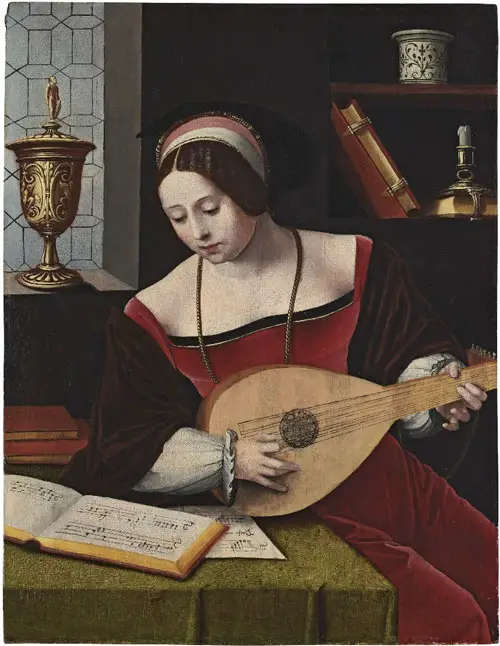
Unlike her husband, Henry VIII, and her daughter, Elizabeth I, there are surprisingly very few first-hand accounts of Anne Boleyn’s personal music making. Despite this, her musical attributes are written about and mentioned more than any other of Henry’s wives, both during her lifetime and in subsequent years.
There is no doubt that Anne was gifted in the important courtly attributes of language, conversation, dancing and theatrics and, of course, music. She ‘knew perfectly how to sing and dance….to play the lute and other instruments”, according to Lancelot de Carles, a French bishop, and even one of her critics, Nicholas Sander, admitted that she could play “on the lute and was a good dancer”. A courtier of Francis I, the Count de Chateaubriant described her as such: “she possessed a great talent for poetry, and when she sung, like a second Orpheus, she would have made bears and wolves attentive. She likewise danced the English dances, leaping and jumping with infinite grace and agility. Moreoever, she invented many new figures and steps, which are yet known by her name or by those of the gallant partners with whom she danced them. She was well skilled in all games fashionable at courts. Besides singing like a siren, accompanying herself on the lute, she harped better than king David, and handled cleverly both flute and rebec.”
The image above shows ’The lute player’ by Master of the Female Half-Lengths, Private Collection, c1530
Perhaps this focus on music and Anne is partly down to her alleged association with Mark Smeaton, the court musician, as well as her questionable authorship of a song she composed in the tower whilst awaiting her fate. However, the most tangible evidence we have of Anne’s connection with music is the book of motets in the collection of the Royal College of Music, London, and which bears her name. Her clear love of music must have been attractive to Henry, and, as parents to Elizabeth I, they produced a daughter who was undoubtedly a skilled musician and probably more musically gifted than either of them. In this article I would like to explore the sort of music education Anne would likely to have received and also explore further the music book which she undoubtedly owned.
Throughout the 16th century, music was one of the talents which any well-educated and daughter of noble birth was expected to demonstrate. Richard Mulcaster, head of the Merchant Taylors’ School wrote that princesses especially needed the talents of “reading well, writing faire, singing sweet, playing fine in order to honour themselves and to discharge the duty which the country has committed to their hands”. Courtly women were expected to use music to demonstrate good breeding and it was also a means by which a woman could attract a suitable husband. However, there was a dangerous aspect for women playing music as they could be accused of inciting lust as Venetian courtesans adopted the lute as their badge of trade. Woodwind instruments also could illicit sexual connotations and it meant that female musicians had to be cautious about the contexts and company in which they performed.
We know little of Anne’s time at Blickling where she was born and Hever Castle where she spent her early years but there is no doubt that music would have been part of her soundscape. When Thomas Boleyn extended Hever and built a second story to the castle, a minstrels’ gallery was added to the Great Hall. Thomas would have entertained lavishly and music and dancing would have been a central part of ensuring his guests enjoyed their stay. Anne was not to grow up at Hever though and at 13 was sent to the Netherlandish court of Margaret of Austria in 1513 as a filles d’honeur. Here she would have enjoyed a humanist education and learned the practical skills of an aristocratic woman.
Margaret’s court had one of the largest musical ensembles in Europe and her ladies in waiting would have had a broad musical education befitting a young Renaissance woman. Here she received formal instruction in singing, dancing and instrumental music and she would have taken part in court entertainments, including staged theatrical musical events.
There is supposition that her tutor was Henry Bredemers as he taught other royal children of the court as well. He was a skilled musician and was the official organist to the court. Another possible tutor was Fleurquin Nepotis, a relative of Govard Nepotis, Margaret of Austria’s personal teacher. Fleurquin had been ‘raised and taught music and other studies’ and he was assistant to Bredemers from 1516 onwards, coinciding with Anne’s time at court. He is the more likely candidate, as Anne, as a daughter of an Englishman at a foreign court, would have been among the lower tiered courtiers and would not have warranted the attention of the prestigious Bredemers or Govard Nepotis.
Regardless, Anne’s station would have ensured that she would have been educated in acquiring musical skills such as playing the clavichord and other keyboard instruments and the lute as well as singing and dancing and theatrical skills. One of the primary duties of a filles d’honneur was participating in court dances and Margaret’s court was associated closely with the basse-dance, a couple dance of the period. It was said that “to dance it, one moves tranquilly, without agitation, in the most gracious fashion one is capable of”.
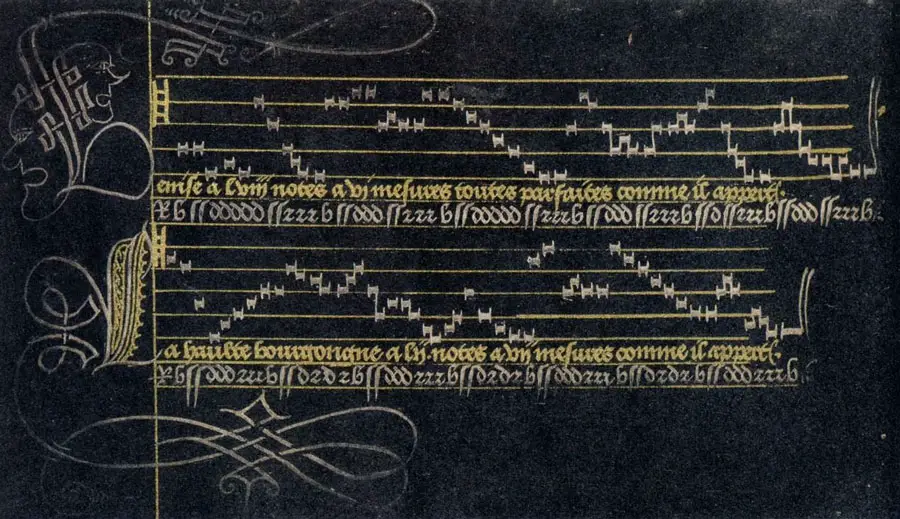
The image above is of The dance book of Margaret of Austria, c1490. Written in silver and gold ink on black parchmen. It includes instructions and music for basse dances – a popular dance of the time which Anne would have received instruction in.
After leaving Margaret’s court, Anne joined Mary Tudor’s retinue at Blois. Although there is little contemporary evidence of her time in France, an account by Lancelot de Carles written after her death said that “she knew how to sing and dance and she proposed to be seduced by the sound of sound and other instruments, to divert her sad thoughts”. It is not known if de Carles ever witnessed Anne’s abilities or whether his observations were gathered from second hand accounts. It is clear though that Anne was particularly attracted to the tastes and fashions she learned at the French court under Queen Claude, who she served having left Mary Tudor. Anne spent seven years with Queen Claude and she was also close to the queen’s relatives, Louise of Savoy, and Marguerite d’Angoulème/Alençon. It was in France that she would have developed her taste in music, manuscripts, poetry dance and the game of love. She would have been exposed to the finest music of the age by some of the leading composers of Europe. Pavanes and Galliards, chansons and other musical styles and dances would all have been part of her regular routines.
On returning to England and joining the retune of Katharine of Aragon, it was remarked that Anne could have been mistaken for a native French woman as her manners, dress, behaviour and style set her apart from the other ladies at court. Her experience of taking part in theatrical entertainments in the French court stood her in good stead when she played a part of Perseverance in the Chateau Vert pageant in 1521, supposedly the first time she and Henry interacted.
Anne’s close association with Marguerite is of particular relevance with regards to the book of French chansons which has now become known as Anne Boleyn’s Songbook.
RCM 1070 is a rare and important manuscript collection of French motets dating from the early 16th century. It is held by the Royal College of Music and whilst of undoubted interest to musicologists and early music specialists, it has greater curiosity because of the inscription on folio 79r ‘Mres A Belleyne / Nowe thus’ which seems to suggest that it once belonged to Anne. The collection contains 42 compositions, 7 of which are unique to that document. Josquin Desprez, one of the foremost composers of his age, has 10 pieces and there are other French composers such as Lyset Compère, Jean Mouton and Claudin de Sermisy. There is one piece by the famous Flemish composer Jacob Obrecht, who had travelled through France in 1492. As I have shown, Anne would have had a good musical education and she would have been familiar with many of the composers whose pieces appear in the collection.
The book is a compilation of a series of five bindings. The first three bindings formed the original core of the book and the pieces date to the very beginning of the 16th century, circa 1505-1509, Two bindings were added later. They would have been written out by a professional scribe (five different hands have been identified) and then decorated later by an artist. The book is made from paper and analysis of the paper and the watermarks has shown this to be French. This was a music book that was clearly designed to be used and sung from as all four harmony parts can be viewed at once (during this period, each voice usually had their own part book and there was no ‘score’). The corners of the book have clearly been thumbed and there are various marks added to the music by the singer, such as sharps or flats above the notes – one of the few rare examples of an annotated music manuscript from this period. It is not a highly decorated book and the fact that it is made from paper and not parchment indicates that it was not meant for royalty or for show, but it clearly is for someone of some status. The subjects of the songs contained in the collection have led Lisa Urkevich to suggest that the book could originally have been intended as a wedding gift – songs of love, marriage and the desire to have children.
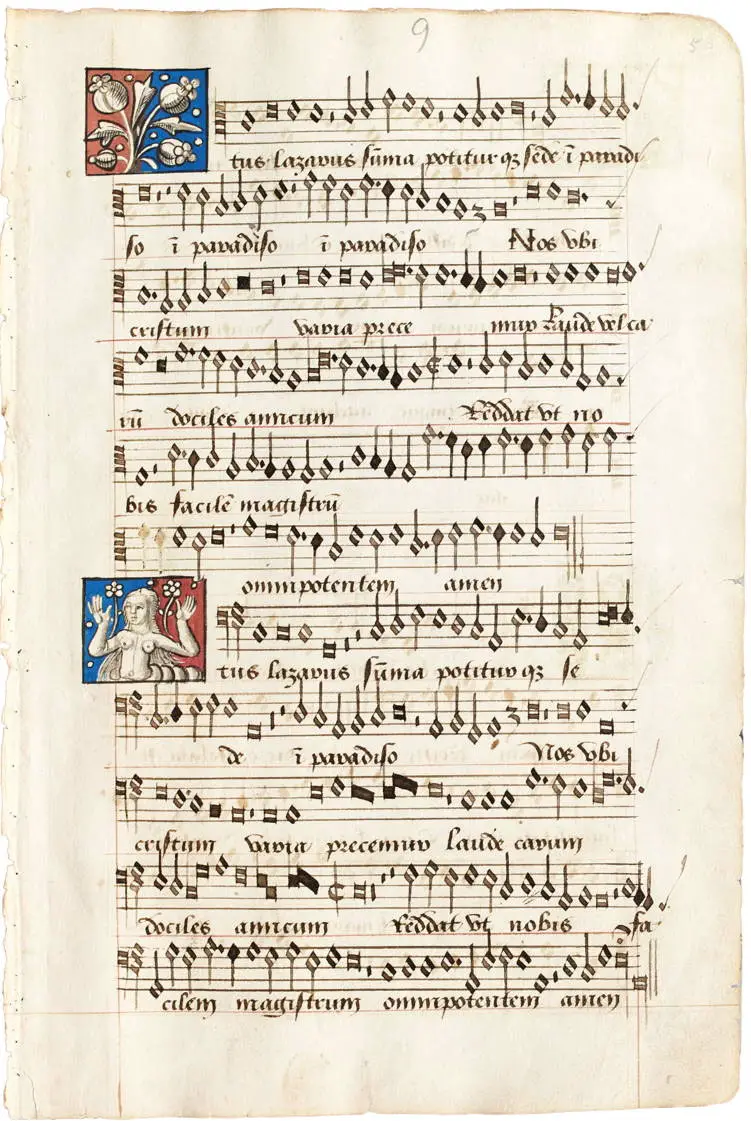
There have been various studies of the manuscript over the years. Edward Lowinsky printed his research in the early 1970s but his observations were flawed because he believed that the book had been compiled for Anne Boleyn whilst she was Queen of England (1533-36) and even suggested that one of the scribes was her lutenist and supposed lover, Mark Smeaton. This view then held for some time and sometimes this flawed research is still, sadly, being quoted. In 1997, Lisa Urkevich gained her PhD with research into the manuscript and suggested that it could be dated to a period before Anne was in France and had most likely been given her as a gift by Marguerite d’Alençon.
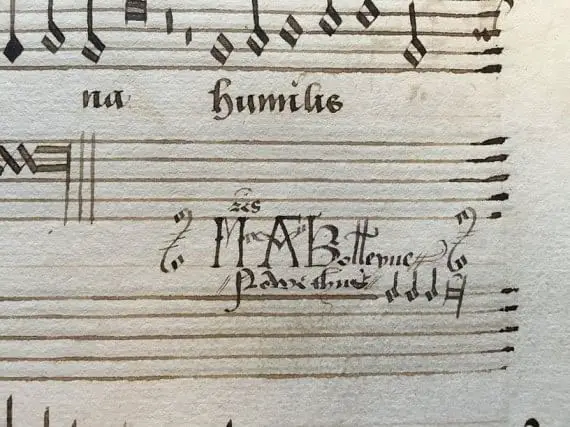
A curious aspect of the signature in this image is that is appears in the middle of the document alongside the alto part of a piece by Loyset Compère. Nowe Thus was a Boleyn family motto and there are other Annes in the Boleyn family. Thomas Boleyn had two sisters, Anne Clere (1487-1538) and Anne Shelton (1475-1555), both of whom could have inscribed themselves as Mres A Belleyne. But neither are shown to have received a formal education in France or had a particular interest in music so we must assume that it is the Anne Boleyn.
There has been speculation about the minims and longa, with a downward tail, (musical notes) shown underneath the signature. Lowinsky stated that the minims referred to her three years as queen and the ‘longa’ showed the end of her time. Eric Ives, in his biography of Anne, took a similar view in that the three minims could be a code for the period that Anne and Henry knew was unavoidable before the longa of the conclusion. However, Urkevich proposed that, as queen, Anne would not have used the lowly title of ‘mistress’ or her father’s motto. Following her father’s rise to the peerage as Viscount Rochford in 1529, Anne stopped using the title ‘Mistress’ and she is henceforth known as Lady Anne Rochford and after 1532, Marchioness of Pembroke. Therefore, the inscription in the music book must have been made prior to 1529 and at a time when she did not know Henry. She suggests that the musical notation could symbolise her age at the time or simply be a musical design. Urkevich concludes that a professional scribe could have written the inscription as the handwriting does not match Anne’s and the musical notation is expertly drawn.
One of the pieces in the book Jouyssance vous donneray by Claudin de Sermisy was a very popular chanson on the time and Sermisy was a favourite musician of the French court. There is a strong association between the French court poet, Clément Moran, and Marguerite d’Alençon. One of Moran’s poems was set to the tune of Jouyassance and it was a known favourite of Marguerite’s and she used the tune in a theatrical production she commissioned. The music for Jouyssance can be seen being played by the women in the famous painting by The Master of the Female Half-Lengths. Eric Ives even suggested that the inclusion of this piece of music pertained to Henry and Anne’s situation during their courting years from 1526 to 1533. The words of the song “I will give you pleasure, my dear, and thus I will ensure that what you hope for ends well … but if it weighs you down, appease your hurting heart: everything will be good for those who wait”. Eric Ives has even posited that Henry and Anne sang this together – this is, of course, pure speculation and fanciful guesswork.
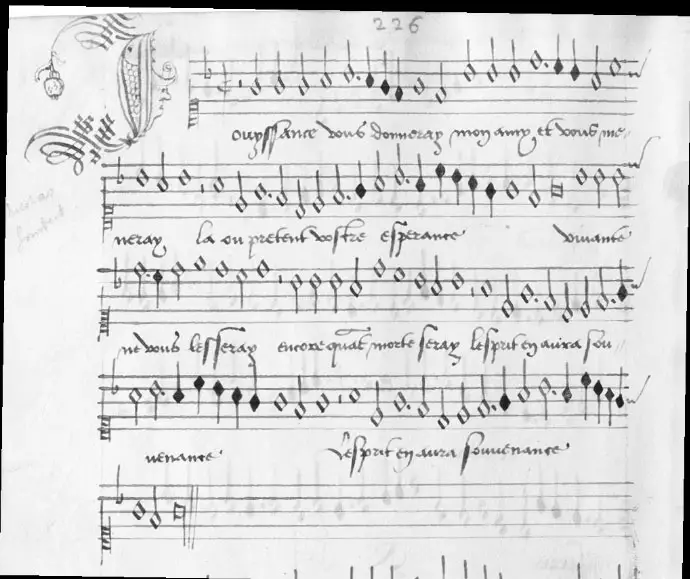
The image above shows Jouyssance vous donneray as it appears in the song book.
There is still much debate by musicologists about the exact history and origins of this songbook. However, all are agreed that it is French and it dates from the early 16th century. Following research by Lisa Urkevich, studying the music, the paper, the watermarks and other initials found in the book (such as MA), her theory that the book was at one point owned by Marguerite d’Alençon, has now become established. It was probably originally compiled for her as a gift for a wedding that never took place, and this would explain why the various bindings have empty pages and it is clearly unfinished. However, Marguerite kept the book for her own use and later added some extra pieces. Some years later Anne and Marguerite formed a close friendship and the two could have used the book for their own performances. When Anne was recalled to England for a proposed marriage in 1521, Marguerite gave her the book as a parting gift. Was it at this point the Boleyne inscription was added or was it added when Anne sang from the part on which the signature appears?
No doubt study and speculation into the music book will continue but suffice to say, it will always be known as Anne Boleyn’s Songbook and it is a tantalising thought that this book would have been held by Anne and she would have sung the words and followed the music contained within it. A precious document indeed.
In 2015, the music group Alamire, directed by David Skinner recorded some of the pieces from the book and the CD is available on the Obsidian label. https://www.obsidianrecords.co.uk/cd715
References
- Butler, Katherine. “‘By Instruments Her Powers Appeare’: Music and Authority in the Reign of Queen Elizabeth I.” Renaissance Quarterly, vol. 65, no. 2, 2012, pp. 353–384
- Little, Brooke Catherine, The Musical Education and Involvement of the Six Wives of Henry VIII: MA Mus thesis, University of Missouri, 2017
- Urkevich, Lisa. “Music Books of Women: Private Treasures and Personal Revelations.” Early Modern Women, vol. 4, 2009, pp. 175–185.
- Urkevich, Lisa "Anne Boleyn, a music book, and the northern Renaissance courts : Music Manuscript 1070 of the Royal College of Music, London." PhD dissertation, University of Maryland, 1997.
- Skinner, David “The Anne Boleyn Music Book”, pp1-9, DIAMM Facsimiles, OUP, 2017 Siemens, Raymond G. “Henry VIII as Writer and Lyricist.” The Musical Quarterly, vol. 92, no. 1/2, 2009, pp. 136–166. JSTOR, www.jstor.org/stable/27751856. Accessed 15 June 2021.